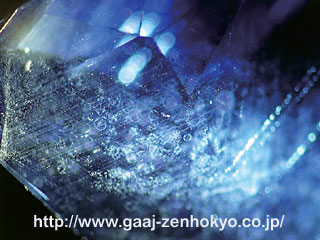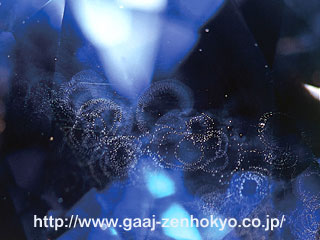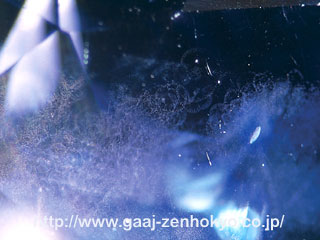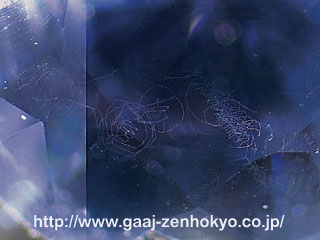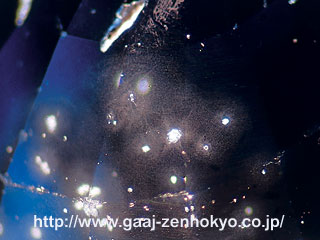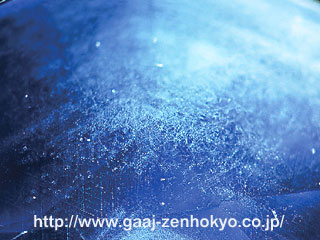|
Identification Features of Be-diffused Blue Sapphire
@@In all the Be-diffused blue sapphires confirmed at GAAJ laboratory, colour zoning along crystal structure was observed but no colour concentration along the rim (called ecoloured rimf) was recognised. Dotted silk or fused crystal inclusions, which are commonly seen in blue sapphire heated in high temperature or in prolonged period, were also observed. It is notable that circle to helical (hair-like or spider web-like) inclusions were recognised in all the Be-diffused blue sapphire investigated (photo 2`7). These inclusions are not observed in unheated or traditional heated stones and they can be important clues in standard gem identification tests.
Sub-illumination with a strong fibre optic light is inevitable to observe such inclusions because dark field illumination installed in a gem microscope is no use (photo 8a and b).
Other effective techniques to identify blue sapphire are UV-visible spectroscopy and infrared spectroscopy, as heated stones show variation on their spectra in UV-visible and infrared region. In general, non-basaltic origin unheated blue sapphire from Sri Lanka, Myanmar and Madagascar do not show any characteristic absorption in infrared region. However, when these stones are heated in reducing atmosphere (especially with using hydrogen gas) OH-related absorption that does not exist before heating emerges after the treatment. This indicates that if stones that seem to be geuda indicate heat-treated features but do not show OH peak in spectrum, they have highly possibly been heated in oxidising atmosphere, that is, they may be Be diffusion treated. Detection of Beryllium and Its Limitation In standard gem identification tests, Be diffusion treatment can be determined only when peripheral colour distribution is confirmed. Be-diffused blue sapphire, unfortunately, does not show this colour feature. Unique circle shape inclusion implies the possibility of the treatment, but it cannot be assertive. Advanced analytical techniques are required to detect Be. Leading gemmological laboratories in the world now start using LA-ICP-MS and LIBS. LIBS has detection limit of 1 to 2 ppm. Researchers estimate that more than 2ppm of beryllium may be required to engage in colour change (although this theory needs to be thoroughly studied and discussed), so that detection of purposely operated Be-diffusion treatment should be possible by LIBS analysis. LA-ICP-MS has detection limit of about 0.1ppm and it can even detect Be infused incidentally, however, if the content of Be is very low the detection results show fluctuation by location, therefore analysis must be made on several areas on a sample. There are still much more to discuss hereafter on the criterion of Be content for determination of Be-diffusion treatment or on standard specimens for measurement. References Scarratt K. (2002) Orange-pink sapphire alert. American Gem Trade Association, http://www.agta.org/consumer/gtclab/orangesappirealert.htm. Emmett J.L., Scarratt K., McClure S.F., Moses T., Douthit T.R., Hughes R., Novak S., Shigley J.E., Wang W., Bordelon O., Kane R.E. (2003) Beryllium diffusion of ruby and sapphire. Gems & Gemology, Vol. 39, No. 2, pp. 84-135. Shida J., Kitawaki H, Abduriyim A. (2002) Investigation of corundum heat-treated by a new technique. Journal of the Gemmological Society of Japan, Vol. 24, No. 1-4, pp.13-23. Pisutha-Arnond V., H_ger T., Watanakul P., Atichat W. (2002) Lab News:A brief summary on a cause of color in pink-orange, orange and yellow sapphires produced by the new heating technique. http://www.git.or.th/eng/eng_lab/eng_lab_news/eng_news_on_22_november_2002.htm. |
||||||||||||||||||
|
||||||||||||||||||
